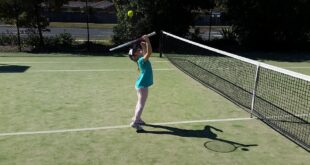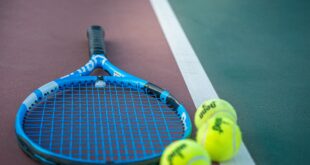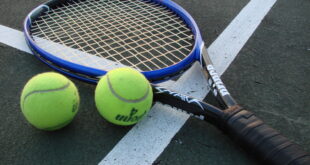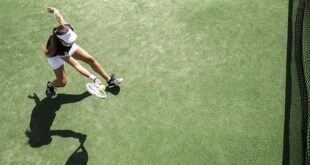The latest tennis racquet manufacturing techniques have opened endless possibilities that can help you improve your game even further. There will be a racquet built for your requirements, regardless of your specialty or weakness.
The universe has bestowed numerous benefits on left-handers. One of them would be having an additional edge in tennis, readily opening the courts from the benefits end. As a southpaw, you may believe that you need to grip your racket uniquely. Of course, you do; however, the grips are essentially a mirror reflection of the grips used by right-handed people.
Once you’ve figured out where to look for the grips, play around with them to find the ones that best suit your way of playing. As per statistics, approximately 10% of tennis players are left-handed. That is why we have decided to create reviews of some of the top left-handed tennis racquets. So, let’s dive in and see which racquet is best suited for your needs.
Table of Contents
What is the importance of a Tennis Racquet?
No tennis player can play without a racket, and a person’s racket’s technical aspects significantly impact their play. Therefore, it’s crucial to consider these aspects while deciding which racket to use.
Tennis racquet technology has advanced dramatically in the last 50 years. In the 1970s, wooden rackets were the most popular. Metal frames were fashionable for a while, but the switch to graphite frames in the 1980s was the next big thing. A wide range of composites spanning from titanium to graphene has been used to construct tennis rackets ever since.
Modern rackets can be built longer, with bigger heads, while being substantially light and sharper than their wooden forefathers. Because of these traits, new equipment makes it considerably easier to strike the ball forcefully and add spin.
Top 5 picks: The best Tennis Racquets for Left-Handers
The Babolat Pure Aero 2019 includes several new features. A beautiful matte black and yellow finish are one of them. In addition, the Aero modular beam architecture of this new and improved aero series helps to reduce wind drag. As a result, the racquet head’s speed is improved.
This model is ideal for left-handed players since it incorporates Babolat’s cortical pure feel, making the response arm comfortable at the touch. In addition, Babolat has included a carbon ply stabilizer in the racquet to enhance its stability.
This stabilizer is placed above the neck to improve precision and consistency when playing. It weighs 11 ounces and measures 27 inches in length, making it ideal for beginner tennis players. All of the characteristics of this racquet come together to create a device that provides an exceptional feel in all parts of the game, particularly at the net. As a result, players feel connected to the ball and are much more assured in their technique, allowing them to smash with elegance and accurately direct the ball.
Pros:
- Has a great spin
- Enhances overall play in every area of the game
- Lightweight
- Delivers powerful shots easily
Cons:
- It can be hard on the arm
- Flat shots are not accurate
Wilson Blade 98 (16×19) Countervail Tennis Racquet
Wilson is the very first name that comes to view when it comes to racquets for southpaws. So naturally, Wilson has taken a leading role in the tennis market, which is why they have a tennis racquet for each player. The Wilson Blade 98 CV is a renowned frame that combines ingenuity with superior power and influence.
This tennis racquet comes unstrung and has a tri-coloured style with lime green, black, and silver flexible layer of paint. Wilson’s blade 98 CV frame incorporates Feel Flex technology for added flexibility and a more connected-to-the-ball sensation. Carbon mapping is deliberately distributed all through the tennis hoop with this technique.
An upper grip taper is available for left-handed players, providing an excellent feel for top handgrip positioning. Aside from that, the Wilson Blade 98 Countervail features excellent distribution of weight, making it an outstanding alternative for certain volleyballers.
Groundstrokes were our favourite movement with the Wilson Blade 98 because of the mix of power and backspin. In addition, the frame is easy to manoeuvre, and players won’t have to exert too much effort to keep up with the game’s speed.
Generally, you can expect a steady reaction from the body while also enjoying a larger sweet spot, which means you’ll get a little more from your off-centre shots. All in all, if you’re looking for a strong tennis racquet without sacrificing control, the Wilson Blade 98 is the racquet for you. However, it does appeal to a selected group of players who possess the necessary strength and confidence to handle it.
Pros:
- Arm friendly
- Stability and good feel
- The racquet is lightweight
- It has more sweet spots
Cons:
- It can be hard to swing
- The colour scheme is not very impressive
- Some issues with backhanding
The beam is 21.5 mm in diameter all the way around. Wilson is a well-known name in the tennis world, which is why they continue to improve their sports racquets in response to player requirements. The Pro Staff 97 now has an upgrade to their time-tested interwoven graphite and Kevlar structure that runs all through the body, which is one of the structure’s most significant changes.
The weave direction has been modified to 45 degrees as a component of Wilson’s Braid 45 improvement for a greater feel and ball pocket. This is a significant improvement over the past version.
Wilson’s String Mapping Tech gets tight from the centre for a thicker string bed and a sweet spot. Increased control and touch are also used on the racquet. The racquet’s 1619 string design, on the other hand, provides plenty of spins.
Accuracy and control have remained a distinguishing feature of the Pro Staff line of racquets throughout the years, and the Pro Staff 97 is no different. In addition, the Pro Staff 97 is a top-notch chassis for all-court play when you add in a dash of excellent stability. Overall, it is an ideal tennis racquet that allows left-handed tennis players to serve with exceptional force and consistency; that is why it is on our list in the first place.
Pros:
- Extra spin is offered
- Easy to swig by
- You can play it from all areas of the field
- Comes with a warranty
Cons:
- It can be stiff at times
- The weight can cause your arm to ache
It’s a racquet that performs admirably across the board, making it a fantastic choice for all-court players who prefer hanging out on the side-line, roaming around the field, and approaching the net.
Ultimately, the VCORE Pro will appeal to a wide spectrum of players searching for precision without the severe weight that many control-oriented racquets entail. Of course, as you’d expect from Yonex, this racquet is loaded with innovative advancements to provide an exceptional hitting experience. Yonex has updated the racquet’s throat design for 2021 with the inclusion of 2G-NAMD graphite to enhance flex and, as a result, ball-pocketing and topspin capability.
Yonex also includes a shock-absorbent material called Flex Fuse for added comfort. In addition, the Isometric square head form, which enhances the size of the sweet spot, is featured on the Head. Likewise, extensive grooves in the 3D vector axis prevent frame bending and boost stability.
Aside from that, the smaller Head makes it easy to manoeuvre. It is, without a doubt, the ideal tennis racquet for players. In terms of spin patterns, the 16 x 20 string pattern produces spin based on your power so that you may confidently and fiercely hit targets.
Lastly, this tennis racquet is designed for players at the beginners and advanced levels. Because of its modest sweet spot and medium head size, it’s an ideal racquet for left-handers as well.
Pros:
- Provides a firm feel
- Has a movable head
- Spin friendly
- Easy to access power
Cons:
- Not very stable
- It can be expensive for some people
Graphene 360, an extremely durable nanomaterial, is one of the racquet’s primary qualities. It’s analogous to regular graphite on steroids. This was formerly solely utilized on the racquet’s neck and handle.
On the other hand, Head uses Graphene 360 through the racquet’s Head at 3, 9, and twelve o’clock. Therefore, you’ll have a little more power while maintaining the same incredible control. In addition, graphene decreases the racquet’s weight through the middle of the frame, allowing the Head to disperse that weight to create a fast-swinging, compact, and manoeuvrable racquet.
The new edition also has a wider 18 x 20 string pattern, making hitting with depth, force, and spin. The Head is 100 square inches in size, which provides a large, sweet spot for playing with a lot of force and spin.
The Head Graphene 360+ Speed MP feels excellent in your hand, which is one of the primary features you’ll discover. It feels robust at 11.2 ounces, but it flies thanks smoothly to its 4-point headlight balancing.
This lightness and stability combine to create a highly enjoyable tennis racquet that enables you to accelerate fast through touch and make large cutbacks at the ball from the side-line while maintaining superb topspin accuracy. On the pitch, it is also favoured among left-handed players.
Pros:
- A perfect blend of control and power
- User friendly
- Best for beginners and intermediate players
- String bed is more open
Cons:
- It can be a bit hard to swing at times
What to Look for when buying the Best Tennis Racquet for Left-Handers: The Ultimate Buying Guide
Choosing a suitable tennis racquet for left-handed athletes can be difficult, particularly for the first time. When shopping for the perfect tennis racquet, there are a lot of things to consider.
We’ve made it easier for you by providing a short and snappy tennis racquet ‘guidebook-‘ if you will. This buying guide gives you complete satisfaction, and you will be able to purchase the finest tennis racquet without any difficulty.
Size of The Head
With all other factors being constant, the greater the racquet head diameter, the more energy a person can create. A greater sweet spot and higher power are associated with a bigger head size. The average head size is between 85 and 115 square inches, with the following dimensions:
- Midsize is defined as 85-96 square feet.
- Mid Plus is defined as 96-106 square feet.
- A head size that is 107 to 115 square feet is considered big.
The main advantage of bigger head size is that it allows for more tolerance on off-centre shots. It’s because the bigger the head size, the less the racquet bends on contact due to the weight all across the string bed. However, as is customary, a bigger head size will lead to less command as it becomes more difficult to give and operate in the desired manner.
Weight of the Racquet
The weight of a tennis racquet ranges from 240 to 310 grams. The key aspect that defines a racquet’s strength is its weight, which can significantly impact your performance. A heavier racquet is more solid and less likely to transmit stress. As a result, it helps take charge in rapid swings and provides greater force behind the ball.
The body’s stability when you attempt to play the ball is another factor that weight has on. Remember, it’s simply physics: when there’s more weight at the contact point, the steadiness of the racquet in your palm is less likely to alter. Consequently, heavy racquets feel more solid than those that are lighter.
A lighter racquet aids in the generation of many spins in the match. Lightweight racquets can be made heavier by adding extra mass. Mid-weight racquets with weights ranging from 270 to 295 grams offer a good balance of power and domination. As a result, it’s an excellent alternative for club players looking to enhance their game.
Stiffness of The Racquet
The rigidity of a racquet is related to how much it flexes when it hits a ball and how it influences the strength of a shot. Because a stronger racquet folds less, it allows for more power. As energy is removed from the ball, a pliable racquet folds more, leading to less power. Racquets aren’t designed to work like slingshots, so if a frame folds back, it won’t be able to contact the ball quickly enough to send it ahead.
Apart from power, a frame’s rigidity affects comfort and stability. Again, it comes down to personal taste, and there isn’t much variation between most frames in the industry, even if they have varying stiffness classifications.
String Pattern
The string pattern mainly changes the level of spin a player can apply to the ball and the string’s resilience and life. 16 x 19 and 18 x 20 are by far the most typical sizes. These indicate how much string is on the main strings and cross strings.
Compared to a tighter string pattern, a loose pattern, such as the 16 x 19, enables individuals to apply more spin on the ball. It’s because all other factors are held constant. There’s greater space seen between strings, so they travel more and spring back into position.
A tighter string pattern normally implies more string longevity since there is less motion on the strings, which means less abrasion and hence less spin.
Grip Size
Every person was born with a unique hand size. Handles have a diameter of 4 1/8 to 4 5/8 inches across the circumference. Though the change is minor, it has a significant effect on production. As a result, you will be safeguarded from a wide range of ailments if you use a racquet with the proper grip size.
High grip size can cause muscle fatigue, whereas a tiny grip size can put undue strain on the wrist and elbow. So, there is harm in both circumstances. As a result, selecting racquets based on your grip size is recommended.
Comfort
Various tennis players equate pleasure with specific situations. For instance, one player may find it more pleasant if a racquet transfers less stress and vibrations through the forearm when striking the ball. On the other extreme, some other athletes might link comfort to body power and racquet weight percentage.
Length
A racquet’s length generally spans from 26.5 to 29 inches. Wider racquets are significantly lighter than regular frames. They also have a longer reach on groundstrokes and serve strength. Furthermore, they have a heavy swing weight, which necessitates more effort to manoeuvre the racquet.
Frequently Asked Questions
How do Left-Handed Players Grip the Racquet?
Tennis racquets are intended for both right-handers and lefties, regardless of which arm you use. Grips are easy to understand because they are the inverse of a right-handed person’s grasp. A small tennis gripping instruction for southpaws is provided below for this reason.
First and foremost, get a firm grasp. Next, you’ll need to lay your racquet on two places on your hand. Your initial finger’s base knuckle and the palm’s heels pad. The “grip-change repositioning line” is an artificial line drawn between these two places.
Next, with your racquet’s Head pointed away from yourself, place it on this line. If you look closely at the underside of the butt cap, you’ll notice eight sides of grips known as “bevels.” The first level is referred to as 1. If you’re holding it with your right hand, rotate it clockwise and call the next right angle.
If you’re holding it in your left hand, rotate it counterclockwise and label the second left angle as 2. This is how you can tell whether your tennis racquets have distinct levels. There are a total of eight levels.
What advantages do left-handed players have?
Left-handed tennis players have numerous benefits, and statistical data from the United States Tennis Association demonstrate that about 10% of players worldwide are left-handed. From Jimmy Connors and John McEnroe to Martina Navratilova and Rafael Nadal, numerous southpaws have demonstrated excellence over the decades.
Many significant titles have been won by champions who are left-handed. You can apply the techniques used by world-class southpaws at the club level as well. A lefty who hits a crosscourt forehand has a more piercing side spin than a righty who hits the same ball. In addition, the service is the most crucial component. The lefty appears to have a more accurate slice serve, albeit his kick isn’t as effective.
Is it better to be right-handed or Left-Handed in Tennis?
With a hard forehand winner, the leftie can retrieve the serve. Due to their higher winning rate, lefties have a greater likelihood of success on grassy and clay courts than hard courts. Furthermore, with their strong backhand, they can readily defend strokes from right-handed players.
Final Verdict
Choosing the Perfect Tennis Racquet that meets your demands while also helping you develop your game can be a difficult task. A bad racquet may destroy your game and technique. As a result, it’s always worth taking the time to figure out which tennis racket is perfect for you.
You probably wouldn’t be able to use the same tennis racquet for the rest of your life since your skill level will rise over time, and you’ll need to change your present racquet to take your team to the next level.
Whether you’re a lefty or a righty, we are confident that our review will assist you in selecting the most exquisite tennis racquet.
 UniSportOnline The world of everything sport
UniSportOnline The world of everything sport








